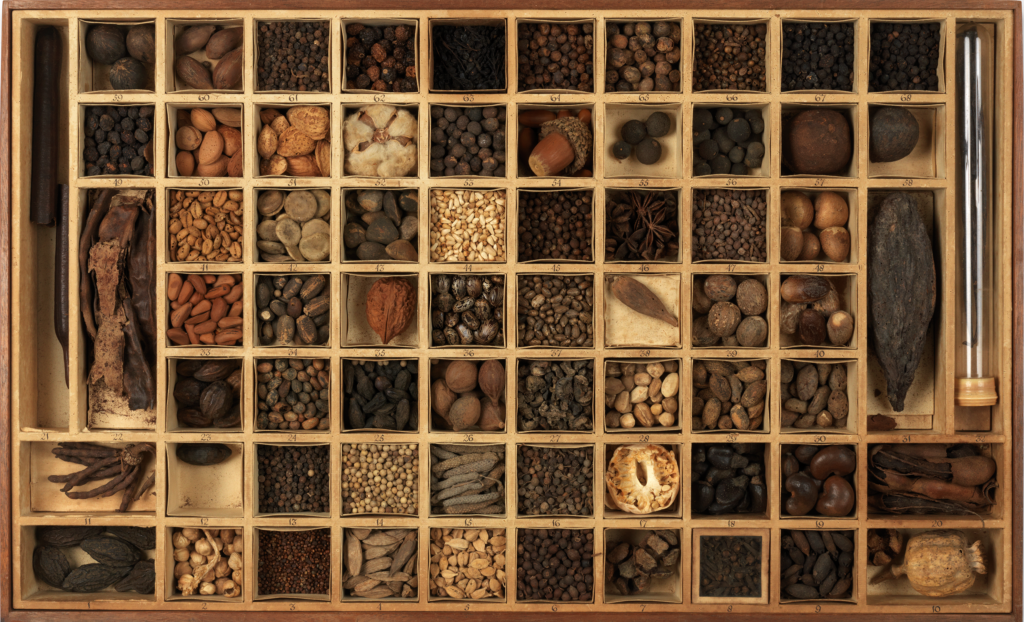From the seventeenth century through the early nineteenth century—the years of focus of this exhibition and an intense period of natural historical investigation—animals, plants, minerals, and cultural artifacts from across the globe entered the collections of European and American curiosity cabinets. Some fell under the watchful study of naturalists as specimens; some showcased the power and prestige of the collector or celebrated the spoils of empire; and still others came to be used as medicines or scientific instruments. But a number of these artifacts entered such spaces as potential food items, too—and many more never arrived to these early museums at all because they were instead hunted, felt, tasted, and devoured in the wake of the cultural collisions that defined the work of natural history. This exhibition explores the entangled histories of food and natural science, while also considering the extractive and consumptive enterprises that bound the two.
The exhibition’s title gestures toward the latent food nature of many of the objects stored within such cabinets of curiosities, be they literal furniture cabinets, stocked with naturalia and artificialia drawer by drawer, or grand chambers spanning one or several rooms of a building. A drawer in the mahogany simples cabinet of Amsterdam physician Hendrik de Bosch, pictured here, captures the historical fusion of science and food in microcosm: to this day it brims with centuries-old cardamom seeds, tamarind, an array of dried peppers, pistachios, tapering vanilla beans, nutmeg, coffee beans, star anise, dried apples, and other edible remnants, a veritable kitchen in a cabinet.

The history of natural history and the history of food have largely been studied as separate histories. But many natural things in the early modern period were, at their core, consumable. Natural history texts and correspondence documented the viability of plants and animals as foodstuffs; trying circumstances could force naturalists to eat their specimens instead of preserving them; and naturalists used food itself—from rum to oats to bread—to prepare and transport specimens. While food historians and material culture scholars rightly lament the scarcity of historical foodstuffs preserved in archives (given food’s transient nature), the collections of natural history museums offer tangible evidence of early modern foodways due to the ever-entwined acts of studying nature and eating nature. Objects’ simultaneous status as curiosities and as foods drove the material practices of natural history, particularly in British imperial investigations of so-called new worlds.
The transit of these objects to metropolitan centers could be more violent than peaceful: some made their way to such collections on the figurative backs of enslaved and Indigenous people, as naturalists capitalized on non-European knowledge systems or otherwise accomplished their scientific work as part of imperial projects that dispossessed Native nations and robbed millions of Africans of their legal personhood. This exhibition confronts the violence of natural history investigation, but it also explores moments of resilience, where food objects and natural specimens of the early modern period offered opportunities for resistance and knowledge creation to marginalized historical groups. Moreover, it probes the ripple effects that these past power struggles have had on matters of food justice and environmental destruction today.
As you explore this assemblage of food artifacts, keep in mind the temporary and fleeting nature of many of the items digitally preserved here. A variety of museums are moving to deaccession objects in their collections, for reasons ranging from financial stress to repatriation claims. And a few are considering the removal of organic food artifacts altogether, as they can attract hungry insects and thus threaten other collections in these spaces. As apparent to animal appetites as to people, the alimentary nature of these specimens has held true over time. But it might also imperil their future.